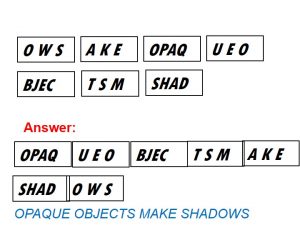Light, Shadows and Reflections
Exercise:
1). Rearrange the boxes given below to make a sentence that helps us understand opaque objects.

2). Classify the objects or materials given below as opaque, transparent or translucent and luminous or non-luminous:
Air, water, a piece of rock, a sheet of aluminium, a mirror, a wooden board, a sheet of polythene, a CD, smoke, a sheet of plane glass, fog, a piece of red hot iron, an umbrella, a lighted fluorescent tube, a wall, a sheet of carbon paper, the flame of a gas burner, a sheet of cardboard, a lighted torch, a sheet of cellophane, a wire mesh, kerosene stove, sun, firefly, moon.
| opaque | Transparent | translucent |
| a piece of rock
a sheet of aluminum a mirror a wooden board a CD a piece of red hot iron an umbrella a lighted fluorescent tube a wall a sheet of carbon paper a lighted torch kerosene stove sun firefly moon
|
Air
Water a sheet of plane glass a sheet of cellophane
|
a sheet of polythene
smoke fog
|
Luminous and non-luminous
| Luminous | non-luminous |
| a piece of red hot iron, a lighted fluorescent tube, the flame of a gas burner, a lighted torch, kerosene stove, sun, firefly.
|
Air, water, a piece of rock, a sheet of aluminum, a mirror, a wooden board, a sheet of polythene, a CD, smoke, a sheet of plane glass, fog, an umbrella, a wall, a sheet of carbon paper, a sheet of cardboard, a lighted torch, a sheet of
cellophane, a wire mesh, moon.
|
3). Can you think of creating a shape that would give a circular shadow if held in one way and a rectangular shadow if held in another way?
Yes, a cylinder.
4). In a completely dark room, if you hold up a mirror in front of you, will you see a reflection of yourself in the mirror?
No, we cannot see a reflection because in the absence of light no reflection of light takes place and an image is not formed.
Additional questions:
1). Write whether True or False:
a). Without light, things can be seen.
False.
b). The torch bulb is an object that gives out the light of its own.
True.
c). The Sun is a luminous object.
True.
d). Shadows give out an accurate picture of the object.
False.
e). Shadows appear in a different colour for the different coloured objects.
False.
f). Light travels in a straight line.
True.
g). A mirror changes the direction of the light that falls on it.
True.
h) We can see things clearly in the darkroom.
False.
i). Sometimes, the shadows can also mislead us about the shape of the object.
True.
j). The images formed through pin-hole cameras are erect.
False.
2). Fill in the blanks.
i). Light helps us to see things.
ii). Light travels in a straight line.
iii). Never ever look directly at the Sun.
iv). Mirror reflection gives us clear images.
3). Answer the following.
i). Name the two things that give their own light.
The Sun and the torch bulb.
ii). What are luminous objects?
Objects that give out or emit light of their own are called luminous objects.
iii). When does a shadow is formed?
If opaque objects obstruct the path of light a shadow is formed.
iv). Name the things we need to see a shadow.
We need a source of light, an opaque object, and a screen to see a shadow.
4) Define the following:
i). Luminous objects:
The objects that give out their own light are called luminous objects.
ii). Non-luminous objects:
The objects that do not give out their own light are called as non-luminous objects.
iii). Transparent objects:
The objects that allow the light to pass through them are called as transparent objects.
iv). Translucent objects:
The objects that allow only some part of the light and not the complete light are called as translucent objects.
v). Opaque objects:
The objects that do not allow the light to pass them are called opaque objects.
5). Distinguish between
i). luminous and non-luminous objects
| Luminous objects | Non-luminous objects |
| i). The objects that give out their own light are called luminous objects.
|
i). The objects that do not give out their own light are called non-luminous objects.
|
| ii). The sun, kerosene stove are examples of luminous objects. | ii). The moon, the chair are examples of non-luminous objects |
ii). Transparent and opaque objects
| Transparent objects | Opaque objects |
| i). The objects that allow the light to pass through them are called as transparent objects
|
i). The objects that do not allow the light to pass them are called as opaque objects.
|
| ii). Air and water are examples of transparent objects. | ii). The wall and the stone are examples of opaque objects. |
6). Give reason: Moon is non-luminous.
The light that we see of the moon is not its own light but it is the reflection of the light from the sun, therefore the moon is a non-luminous body.
Click here for the solutions of
11). Light, Shadows and Reflection
10). Motion and the Measurement of Distances
9). The Living Organisms – Characteristics and Habitats
4). Sorting Materials into Groups
1). Food: Where Does It Come From?
![]()

